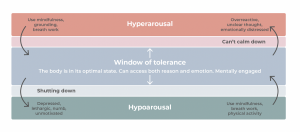The Window of Tolerance explains why some people react more intensely to stress than others. The model is used with trauma, but it can also be used in other situations in which you experience stress. Together with your therapist you will increase your Window of Tolerance: make your window bigger. By doing this you can learn to recognize your own signals in time and learn to effectively handle stressful situations well.
What is the Window of Tolerance?
The concept of Window of Tolerance was introduced by Siegel in 1999. Siegel’s theory gives a good explanation about how emotions can fluctuate. Stress is part of life. A little stress now and again is not necessarily a bad thing and often a good thing; stress can make you more resilient. It is still possible to function well with stress. It is normal to sometimes feel a little more tired, less alert or more irritated and at other moments a little better about yourself. These feelings are within a healthy tension range. You are able to interact well with the people around you, you are able to think, you can empathize with others, you are open to new experiences, you can learn and you can control yourself when necessary. If you experience a particularly stressful situation, you are able to handle it well.
The zone in which someone can handle stress well is called the Window of Tolerance in psychology. If you experience stress and know how to deal with it effectively, you are in your Window of Tolerance. When stress or tension becomes too great or lasts too long, there are two directions you can go in. Are you above your Window of Tolerance? Then you are too tense. We call this hyper arousal. You then go into a ‘fight or flight’ mode: you are irritated, tense and you cannot relax properly. There can be a few different reasons why this happens: something stressful has happened, you worry excessively or, for example, you have slept poorly. In any case, you are not able to put things into perspective and cannot interact effectively with other people. Are you under your window? Then you are not tense enough. We call this hypo arousal. You feel depressed, understimulated, numb and unmotivated You feel stuck in this feeling.

What happens to your body when you are stressed?
Stress releases stress hormones that quickly prepare the body to fight, flee or freeze. The instinctive part of the body takes over. Your body will recover once the stressful situation is over: your heart rate and breathing return to normal, your blood pressure stabilizes, your muscle tension decreases and your digestive system starts working again. For example, when you are comforted or take time to relax, it allows your stress system to calm down. As long as the stress stays within your Window of Tolerance, someone can function properly. But if the stress lasts for a long time and surges past this window, it can become problematic. This is unhealthy and causes long-term stress. It can eventually lead to exhaustion or sickness.
The stress system can become so sensitive that it reacts intensely in situations that are not dangerous. Your brain interprets a situation as threatening or dangerous and the stress system is immediately activated. You then find it very difficult to cope with the stress effectively, meaning that your Window of Tolerance has become much smaller.
Trauma and Window of Tolerance
It is possible that your Window of Tolerance has become much smaller due to a traumatic event and that you quickly feel out of balance. Together with your practitioner you will look for ways to increase your Window of Tolerance.
Increasing your Window of Tolerance
Do you feel like you are always above or below your Window of Tolerance? You are not alone. It often happens that people feel too stressed and/or too numb. You can learn how to better cope with these feelings, and develop skills under the guidance of your therapist. Below are a few examples:
- developing emotion regulation skills
- Learning grounding skills and connecting with the here and now. This technique can be used if you are experiencing flashback or dissociation.
- deep and slow breathing exercises to help you feel more relaxed.
- communicating with others: Learning to tell others how you feel.
- have fun and laugh, for example dancing and singing. This also improves our fitness and breathing
Sources
https://www.psychologievandaag.nl/zelf-doen/de-kunst-van-het-wachten-en-de-window-of-tolerance/
https://nielsvansanten.nl/stress-in-je-lichaam/stress-je-hersenen-en-het-window-of-tolerance/
https://www.youtube.com/watch?v=U8gLstY6dYc
https://henk50.wordpress.com/2019/07/20/emoties-5-window-of-tolerance/
https://embodiedfacilitator.com/wp-content/uploads/2017/11/Centring-Mark-Walsh-ebook-v2.pdf
https://www.victimsa.org/blog/trauma-and-window-of-tolerance

 Print
Print 

